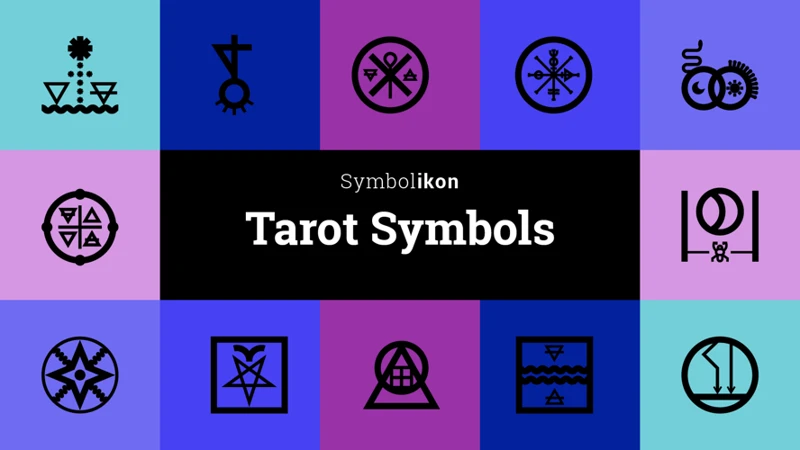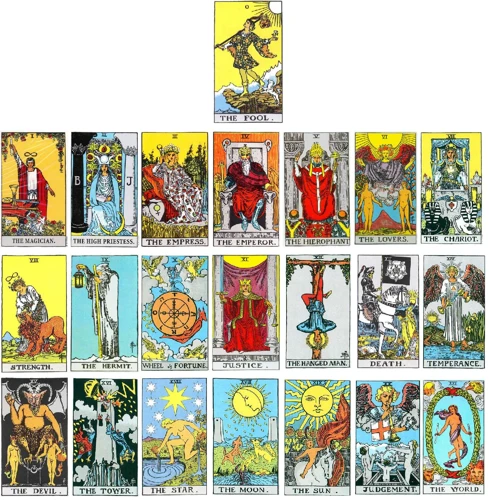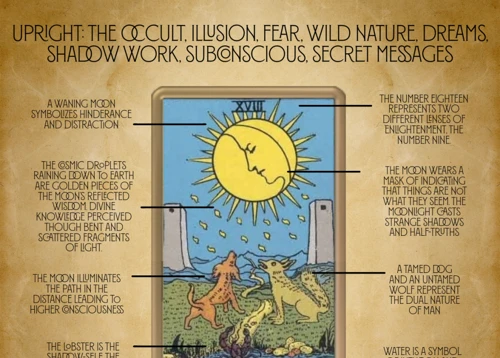Contents
- The Significance of Reversed Tarot Card Symbols
-
Major Arcana
- 1. The Fool
- 2. The Magician
- 3. The High Priestess
- 4. The Empress
- 5. The Emperor
- 6. The Hierophant
- 7. The Lovers
- 8. The Chariot
- 9. Strength
- 10. The Hermit
- 11. Wheel of Fortune
- 12. Justice
- 13. The Hanged Man
- 14. Death
- 15. Temperance
- 16. The Devil
- 17. The Tower
- 18. The Star
- 19. The Moon
- 20. The Sun
- 21. Judgement
- 22. The World
- Minor Arcana
- Conclusion
-
Frequently Asked Questions
- 1. Can reversed tarot card symbols completely change the meaning of a reading?
- 2. Do reversed tarot card symbols always have negative connotations?
- 3. How do reversed tarot card symbols affect timing in a reading?
- 4. Can reversed tarot card symbols indicate hidden opportunities?
- 5. Should reversed tarot card symbols always be interpreted in a negative light?
- 6. How can one interpret reversed tarot card symbols in a reading?
- 7. Can a tarot reader choose to ignore reversed tarot card symbols?
- 8. Are reversed tarot card symbols more significant in certain card spreads?
- 9. Can reversed tarot card symbols indicate a need for introspection?
- 10. Are reversed tarot card symbols universally interpreted or do they vary among readers?
- References
The Significance of Reversed Tarot Card Symbols

Major Arcana

1. The Fool
- 1. The Fool: In the upright position, The Fool represents new beginnings, spontaneity, and taking a leap of faith. However, when reversed, this card takes on a different meaning. Reversed, The Fool suggests recklessness, naivety, or a lack of direction. It serves as a reminder to exercise caution and consider the consequences before taking impulsive actions. The reversed Fool urges individuals to assess their choices carefully and avoid making hasty decisions that could lead to unnecessary risks or negative outcomes. It signifies a need for grounding and practicality in one’s approach to situations. When interpreting the reversed Fool in a tarot reading, it encourages introspection and self-reflection to avoid potential pitfalls. To understand the power of reversal symbolism in tarot cards, you can explore our detailed guide on power reversal symbolism in tarot cards.
2. The Magician
3. The High Priestess
4. The Empress
5. The Emperor
6. The Hierophant
7. The Lovers
In the tarot deck, the card “The Lovers” represents choices, partnerships, and harmony in relationships. When this card appears in a reversed position, it indicates a disruption in these areas. The reversed Lovers card suggests a lack of alignment or conflict between partners. It may signify difficulties in making decisions or feeling torn between two options. In a relationship, the reversed Lovers card can indicate disharmony, disagreements, or a need for communication and compromise. It urges individuals to evaluate their values and priorities to find a resolution. It could also indicate issues of self-love, self-acceptance, or conflicts within oneself. The reversed Lovers card encourages introspection, personal growth, and the exploration of one’s own desires and needs. It is important to approach this card with an open mind and a willingness to address any underlying issues. By doing so, individuals can work towards restoring balance and harmony in their relationships and within themselves.
8. The Chariot
9. Strength
10. The Hermit
11. Wheel of Fortune
12. Justice
- 12. Justice: Justice, when reversed, challenges the notion of fairness and balance. It suggests that a situation may be biased, unjust, or lacking in integrity. This card symbolizes the consequences of dishonesty, inequality, or unethical behavior. In a reversed position, Justice advises us to examine our actions and decisions to ensure they are just and fair. It may indicate that we need to take responsibility for our choices or face the repercussions of our actions. This card serves as a reminder that true justice comes from honoring truth, equality, and fairness. It urges us to seek justice in our own lives and advocate for it in the world around us.
13. The Hanged Man
14. Death
15. Temperance
16. The Devil
17. The Tower
18. The Star
19. The Moon
The Moon is a mystical and enigmatic card in the tarot deck. In its upright position, it signifies intuition, dreams, and the subconscious mind. However, when The Moon appears in the reversed position, its symbolism takes on a different tone. The reversed Moon suggests that there might be confusion, deception, or illusion clouding your perception. It serves as a reminder to trust your instincts as they may be telling you that something isn’t as it seems. It warns against giving in to fear or letting anxieties overwhelm you. The Moon in reverse calls for a careful examination of hidden motives, secrets, and unresolved emotions. It signifies the need to confront your fears and face the truth, even if it feels uncomfortable. This card urges you to trust your inner wisdom and tap into your intuition to navigate through uncertain situations. Remember, the reversed Moon invites you to embrace the shadows and uncover the hidden truths that lie beneath the surface. Explore more about reversed tarot card symbols to deepen your understanding of this intriguing aspect of tarot readings.
20. The Sun
The Sun is a powerful and positive card in the tarot deck, symbolizing joy, vitality, and success. However, when The Sun appears in a reversed position, the meaning shifts slightly. The reversed Sun suggests temporary setbacks, a lack of clarity, or a delay in achieving desired outcomes. It may indicate a period of confusion or a need for additional effort and perseverance to reach your goals. The reversed Sun also cautions against overconfidence or excessive optimism, reminding us to stay grounded and realistic in our pursuits. In relationships, the reversed Sun can signify temporary disagreements or difficulties, but it also offers an opportunity for growth and deeper understanding. It encourages us to address any issues and work towards finding common ground. While the reversed Sun may represent temporary challenges, it reminds us that even in the darkest moments, the sun will eventually rise again, bringing renewed hope and clarity.
21. Judgement
22. The World
Minor Arcana
Suit of Wands
Suit of Cups
Suit of Swords
Suit of Pentacles
Conclusion
Frequently Asked Questions
1. Can reversed tarot card symbols completely change the meaning of a reading?
Yes, reversed tarot card symbols can lead to a significant shift in the interpretation of a reading. They introduce new perspectives, challenges, and potential outcomes that may not be present in the upright positions.
2. Do reversed tarot card symbols always have negative connotations?
No, reversed tarot card symbols do not always indicate negative meanings. While they can represent obstacles or blocks, they can also signify the need for introspection, growth, or a different approach to a situation.
3. How do reversed tarot card symbols affect timing in a reading?
Reversed tarot card symbols can suggest delays, setbacks, or the need for additional time to resolve a situation. The timing associated with these symbols may indicate a need for patience and caution before moving forward.
Yes, reversed tarot card symbols can reveal hidden opportunities that may not be apparent in the upright positions. They can signify the need to explore alternative paths or choices that could lead to positive outcomes.
5. Should reversed tarot card symbols always be interpreted in a negative light?
No, reversed tarot card symbols should not always be interpreted negatively. They can highlight areas of personal growth, self-reflection, and transformative experiences that ultimately lead to positive change.
6. How can one interpret reversed tarot card symbols in a reading?
Interpreting reversed tarot card symbols requires considering the card’s upright meaning and the surrounding cards. It involves exploring themes of blocked energy, subconscious influences, and the potential for growth or resolution.
7. Can a tarot reader choose to ignore reversed tarot card symbols?
Yes, tarot readers have the flexibility to decide whether to include reversed tarot card symbols in their readings or interpret them differently. However, acknowledging and exploring reversed positions can provide valuable insights and depth to the reading.
8. Are reversed tarot card symbols more significant in certain card spreads?
The significance of reversed tarot card symbols can vary depending on the card spread used. Some spreads may emphasize the role of reversed positions more, while others may give equal weight to upright and reversed cards.
9. Can reversed tarot card symbols indicate a need for introspection?
Yes, reversed tarot card symbols often suggest a need for introspection and self-reflection. They encourage the seeker to explore their inner thoughts, emotions, and experiences to gain clarity and understanding.
10. Are reversed tarot card symbols universally interpreted or do they vary among readers?
Interpretations of reversed tarot card symbols can vary among readers based on personal intuition and experience. While there are general meanings associated with each card, each reader brings their unique perspective and insights to the reading.






